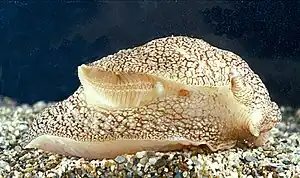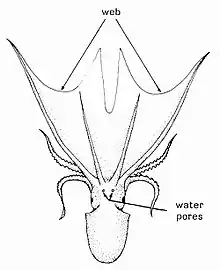
A live individual of Pleurobranchaea meckelii; the ctenidium is visible as a feather-like structure in this view of the right-hand side of the animal
A ctenidium is a respiratory organ or gill which is found in many molluscs. This structure exists in bivalves, cephalopods, Polyplacophorans (chitons), and in aquatic gastropods such as freshwater snails and marine snails.[1] Some aquatic gastropods possess one ctenidium known as monopectinate and others have a pair of ctenidia known as bipectinate.
A ctenidium is shaped like a comb or a feather, with a central part from which many filaments or plate-like structures protrude, lined up in a row. It hangs into the mantle cavity and increases the area available for gas exchange.[2] The word is Latinized but is derived from the Greek ktenidion which means "little comb", being a diminutive of the word kteis meaning comb.
 Pair of large, grey gills visible inside the mantle cavity of a giant squid
Pair of large, grey gills visible inside the mantle cavity of a giant squid
References
- ↑ Ruppert Invertebrate Zoology: A Functional Evolutionary Approach.
- ↑ Respiratory system Archived 2020-08-09 at the Wayback Machine The apple snail. Retrieved 2012-04-20.
This article is issued from Wikipedia. The text is licensed under Creative Commons - Attribution - Sharealike. Additional terms may apply for the media files.


